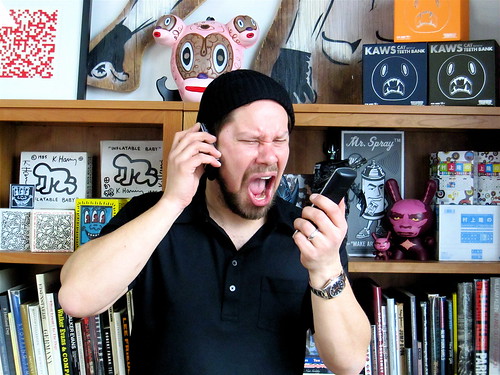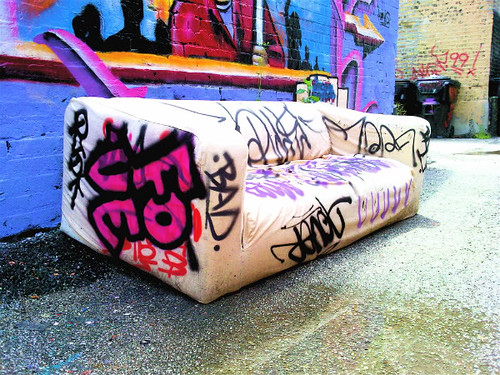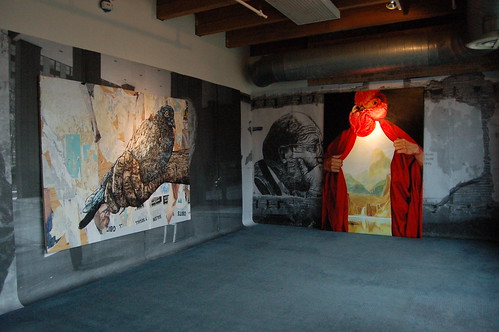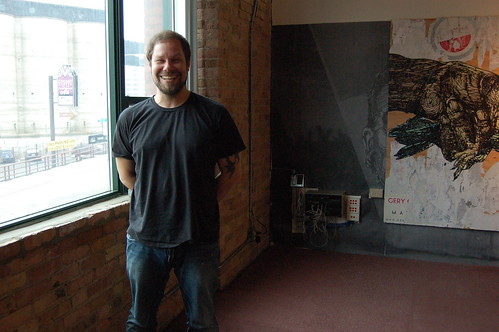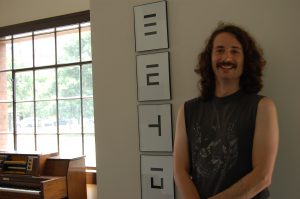![]() Chicago has an abundant history of prolific graffiti writers and street artists. Outside of their own trusted community, many of these artists do not get the chance to speak about their experiences and their love for what they do. This series focuses on giving the microphone back to the artists who create public art in Chicago and those that foster it. Through these interviews our hope is to not only archive the efforts of these artists, but also to achieve a better understanding of the art itself—including why it’s important for graffiti art and street art to continue and receive more support.
Chicago has an abundant history of prolific graffiti writers and street artists. Outside of their own trusted community, many of these artists do not get the chance to speak about their experiences and their love for what they do. This series focuses on giving the microphone back to the artists who create public art in Chicago and those that foster it. Through these interviews our hope is to not only archive the efforts of these artists, but also to achieve a better understanding of the art itself—including why it’s important for graffiti art and street art to continue and receive more support.
Oliver Hild of Maxwell Colette Gallery is undeniably making waves in the street art community. A collector of art since his twenty-something heyday, Hild was ahead of the game as a collector of (tongue in cheek) … “urban art.” And rightfully so, because unlike other collectors who just recently jumped on the street art bandwagon looking to make a quick fortune, Hild has a deep-rooted relationship, knowledge and sincere passion for it. In addition, opposite of those who hoard it all away, Hild is creating a community for established and emerging artists to show at the Maxwell Colette space, and through partnerships with other spaces/organizations who share the same thread, such as Chicago Urban Art Society and Pawn Works. Maybe some might disagree, but Maxwell Colette is shedding some thought-provoking amorous light on Chicago’s prolific public art community.
Right before the launch of Love Flows Both Ways is when I first took notice of the space. After seven months, here it is.
Your book collection is amazing! Do you have any absolute favorites?
My favorite book of all time is a book that was a commitment. The Hirst book over there on the end, I Want to Spend the Rest of My Life Everywhere, with Everyone, One to One, Always, Forever, Now, I bought that book in the nineties when it came out in London, carried it to Paris, back to London and back to Chicago. So that book literally traveled with me [just because I bought it at the beginning of the trip], you know.
That is some luggage to be carrying around!
 Everything about it was just crazy, to be carrying that huge, extremely heavy book around and not getting it damaged in a backpack. It was madness. But arguably it is the best art book that has ever been published. And the inserts, have you ever seen it? The inserts in it are unbelievable. It is Damien Hirst at his most brilliant playful best. That one was signed, and that’s why I bought it.
Everything about it was just crazy, to be carrying that huge, extremely heavy book around and not getting it damaged in a backpack. It was madness. But arguably it is the best art book that has ever been published. And the inserts, have you ever seen it? The inserts in it are unbelievable. It is Damien Hirst at his most brilliant playful best. That one was signed, and that’s why I bought it.
Where did you buy it?
There is a bookstore that used to be just north of Covent Garden, within a block of Covent Garden. The book had just been released, he did a signing there, and I smoked a cigarette with him outside.
What was that experience like?
I didn’t have any real interaction other than standing and a little bit of chatting. But it was at a point when his career was breaking and he wasn’t the Damien Hirst that we know now. There was no hundred million dollar diamond skull and there was no destroying the gallery system, as we know it.
How did you get involved/become interested in public art?
That is an interesting question, because like many people who went to art school who find themselves in their 20s and 30s without the right outlet for their creativity, the public realm just beckons. I am amazed with the number of people who are active right now who trained in art school and make exquisite handcrafted lovely things and leave them in weird locations and have straight jobs.
I have seen a number of these objects around the city and they are not really defacing anything, and still remain under the umbrella of public art.
I have seen a lot of people who do that, and depending on who from Chicago Graffiti Busters of the Chicago Police Department find you doing your thing, you can be met with various levels of resistance. You are talking about a guy leaving stuff that is specifically intended not to harm something. Remember when Nick Adam this past fall was doing those reverse graffiti things where he was cleaning the underpass, and graffiti busters had buffed the clean wall and painted over it?
So then who is the one defacing property?
Exactly! He actually was bettering this, actually cleaning the wall and not harming anything, but they viewed it that any kind of message was so pernicious that you have to paint over it rather than clean the wall and wipe the message away. They could have sprayed the wall with a hose and the message would have vanished rather than paint over it, which is one of those moments of archetypal hypocrisy that makes my head explode.
It is just like this wall in Logan Square where they paint over everything with a different shade of black from the background of the wall, so you can still see the difference between shades and what had originally been painted there.
We spend so much money doing half-ass buff jobs, you know. Somehow this is supposed to be better than leaving it as it was. Something defaced and half-assed covered is supposed to be an improvement? It is like the monkey shit shade of brown, brown rectangles, how this beautifies anything. It shocks me.
I think it is partially because certain people do not want to take the time to differentiate and everything is fair game.
Some stuff people accept, even Graffiti Blasters accept some stuff…
But you have to wonder, has this program actually helped to foster the reduction of crime based on gang-related activity? As far as I am concerned, I am still seeing stuff happening all over the city.
Yes, in the same way that the spray paint ban did not stop graffiti and in the same way that the handgun ban did not stop handgun murders in Chicago. Graffiti Blasters keeps the Loop “looking clean,” and in reality that is Mayor Daley’s real focus in Chicago—the Loop looks good, the further you get from the Loop the less good it has to look, once you cross Western it starts getting hairy and once you get west of California [we don’t even care about the killing anymore]. It is like, “Whatever, do what you want to do down there.” But in the Loop it is working really well. If stuff gets sprayed up in the Loop it gets erased immediately. Through this whole notion of planting flowers and eradicating graffiti in the Loop, we can give people who don’t live here the illusion that this is a pristine, incredibly well-maintained mid-western jewel.
The full gamut of art that is going on in Chicago does not always get the full exposure that it deserves. In the case of street and graffiti art, it practically gets ignored. So the only art that exists in Chicago is at the Art Institute and Museum of Contemporary Art MCA?
And if it has not been voted on some sort of an organization or through some sort of committee to get approved, it lacks the validity—this notion that art by committee is the only true form of public art.
And that is not to say that art in the Art Institute or the MCA is not important. Of course it is, and I am happy that these institutions are here and are able to provide the funding to give our communities a certain access to culture, but there are other types of culture.
Without a doubt—We are right now twenty years ahead of the Art Institute and the MCA having major collections of graffiti art.
Yes! And this is already happening [and without surprise] in L.A, London and New York.
Absolutely, and you’ve got the Deitch show that opens up this month…
Are you going to it?
I am not. I am really curious to see what will happen with it.
And then the public reception of the project that J.R is doing. In my humble opinion, that is the best example of the variety of ways public art can function, as well as how effective it can be.
I love J.R. I sent my photograph for his project but I would love for him to come and do those great big towers across the street.
How exactly did your career begin to unfold?
Like many people in the fine art world, I immediately got sucked into the service industry and spent fifteen years working in bars, running bars, and then owning pieces of bars and restaurants. It completely took over my life. I had always been collecting art. In the early 90s I was obsessive about collecting 19th Century photography. I have large collections of postmortem photographs and of Victorian freak sideshow performer photographs. So I had gone from collecting historical photography to then focusing on more contemporary art, and by 2007 the art world was booming and I realized I could sell these things for a profit before I have even paid for them, with my daughter sitting on my lap, either on a phone or the computer, and I figured “Well, shit, I am going to be an art dealer.”
What is your clientele like?
Up until last fall I would say 95% of my sales for the year were outside of Chicago. Up until the show last fall I had no idea that there was as broad of a base that was appreciative of some of this stuff in Chicago. It is strange. Literally what I did primarily is buy prints from Europe, have them shipped here, wait a bit of time, and ship them back to Europe or even Japan. Now I have a crew of people from Australia who buy stuff from me. It started with the Banksy thing last year in May, [that] was what brought out Chicago collectors.
 Maxwell Colette was a retooling of my whole concept. Before this, as Taser Fine Art we were secondary market dealers exclusively. It was all about being low profile and working with a really select group of people. My business was about being secretive and private and that was part of my cache.
Maxwell Colette was a retooling of my whole concept. Before this, as Taser Fine Art we were secondary market dealers exclusively. It was all about being low profile and working with a really select group of people. My business was about being secretive and private and that was part of my cache.
So you have not always sold street art?
Taser was very much focused on the street thing. My own personal collections have been broader than that. But Taser was initially focused only on the street thing. As Maxwell Colette we have broadened it to include high end multiples from low brow artists, and low end multiples from blue chip artists. So the role of the gallery now is plumbing this grey area between the outsider street art world and the broader contemporary world. I look for people that are already making in-roads; I am not a style maker that is going to find the dude on the street in Chicago and turn him into Banksy. But I look for people that have achieved notoriety in the outsider world and I view our mission as providing them with contextualization in the broader art world. The whole notion of fine art from the guys who are best known for street art is really contrived. It is a strange ground to begin with.
I am interested to know how you would describe the difference between graffiti art and street art.
I would argue that it is all street art and that graffiti is a very distinct group. With semantics I am the worst, because I call it all “street art” even though we know street art can only exist in the street. I call what I sell here street art and we know it can’t be street art. But I hate the term “urban art.” I think it is pejorative and misleading and so much more inappropriate than using the term street art. The fact is that Bansky calls it street art. The day that he refers to it as urban art I will change. What is hilarious is that within the street there is that dichotomy of, “Are you street art or are you graffiti?” Guys who view themselves as outlaws first and foremost and artists second, flock to “graffiti.” Graffiti is one of the four tenants of hip hop culture: mcs, djs, graffiti and breaking.
I think that there is an age difference as far as acceptance of this stuff. I am 42; I remember the world without hip-hop. I remember hip hop as a novelty in those early 80s days and in the mid 80s when hip hop started crossing over and Run DMC and Aerosmith collaborated, the notion that that would become the dominant cultural force on a global scale was unthinkable. No one would have ever believed that that would have broken the way it did. You talk to kids that are ten years younger than me and they have never grown up in a world without hip-hop. Or course, hip-hop, it is everywhere and involved in every aspect of our life at this point. So what we are seeing with the graffiti thing and street art thing is the same kind of thing.
You are a curator, collector and dealer of art. How do you incorporate all those elements into your business, and what keeps you motivated?
When I buy I am an anomaly because pricing is almost secondary. I am the worst kind of dealer because I am at heart a collector more than anything else. I hold too long, I buy multiple copies of things that I really love, and I fall into all of the traps. As a businessperson I have become wiser over the years. The thing that motivates me is still that initial lust where you see a piece of art and you are like, “Holy shit, that is unbelievable!” I want to have that interaction. I want to sit at my desk and look at that Kevin Cyr painting until I get sick of it. So that, first and foremost, is what motivates me. I would rather sit in a room with all of this stuff by myself on my deathbed and I will get the same bang out of it that I got when I purchased it. It is not about the pricing, it is about pieces that really strike me.
So when and why did you decide to function out of this space?
When the market fell apart in 2009 we had to change the whole business structure. The idea of functioning as a middleman and a private dealer was no longer viable. It was the difference between waking up in the morning and checking my inbox and seeing who my clientele was for the day, to waking up trying to figure out how and who I was going to show stuff to, and how am I going to get feet in the door. So what I always swore I would never do, which was to have a brick and mortar gallery, all of a sudden that became something that needed to be incorporated into the business model. Taser Fine Art was founded as an online venture. It was about selling first and foremost online and finding our clientele through a network of collectors and forums and what not.
How has the market changed then?
Street art in 2006 and 2007, everybody got swept up in the Banksy coattails thing. Guys got careers simply because they made stencils. Anybody who was doing anything stencily or streety, there was huge money going into it. Guys like Adam Neate, who was selling for huge money in 2007, has watched his market crumble to nothing. In 2008 when the whole world fell apart, the art world dried up. The stuff that was booming right at the end was the stuff that fell off the cliff. Damien Hirst didn’t sell in 2009 as he had, at that point, saturated his market.
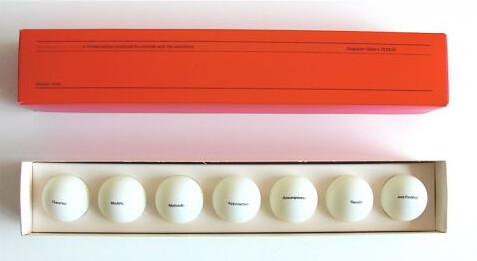 Have you noticed any improvement in the art market?
Have you noticed any improvement in the art market?
Last year there were signs of life in the market. We saw quality works selling but the art market in general, right now, is a hit-or-miss. One thing is hitting really hard but a whole bunch of things are failing to sell. With the street art, there is a whole bunch of new money in the world of Banksy and a whole bunch of new eyes in the world of Banksy, who only got turned on to this stuff like last year after the movie [Exit Through the Gift Shop] and they saw and the Oscar hype. They don’t remember the days when Banksy prints were languishing on the Pictures on Walls website.
Anybody who remembers Bansky in 2003 and 2004 is kicking themselves for not buying up every fucking print that was out there! And it wouldn’t have cost you very much because the prints were only $300 to $400 bucks for a good signed print—for something that you could sell right now for about $10,000 to $15,000. This last round of auctions this spring we saw a really mediocre Banksy original on cardboard, it was a picture of Abraham Lincoln, small size, maybe 18×20, sprayed on cardboard with a presale estimate of about $25,000 and it sold for $70-something-thousand. Banksy prints are doing the same things.
What is the Maxwell Colette thing ultimately about?
The Maxwell Colette name is about two things: first of all, it was about me not being one of those egotistical gallerists who is all about, “This is me inflicting my taste on the world,” and “This is about my name and my vision and what not.” So I wanted it to be outside of that, not some kind of Oliver Hild Gallery thing. And on top of it, then, it coincides with the changing vision and mission of the gallery from being that outsider kind of thing, off the radar, to a conduit, you know, into the broader contemporary art world.
Do you feel like you have influenced or are influencing the way that street art is being received by displaying artwork by street artists?
Without a doubt. I had two people who came in to view the Gaia stuff and wanted to know how we brought Gaia into town, he put stuff out on the street and we took pieces from the street and brought them into the gallery. They thought those giant wooden pieces were things he did on the street and we just took the walls and brought them into our gallery. They thought that was how we operated—in all honesty.
I had to explain to them that these things were actually crafted in our space as fine art pieces and not something that we just took off the walls of somebody’s property. That blew my mind, but this idea of what street art is about and what our role is in it its kind of funny, how people understand it. As far as how we are influencing the street art that is out there right now, I am amazed on a daily basis who drops me e-mails, who is sniffing around, who hits me up on flickr.
That was one of the other last questions I wanted to ask you. I know there was a heated comment thread on Chicagoist going on and on regarding the Gaia show. How does that sort of commentary affect you?
Yes. What is nice is that we are finally prominent enough on the radar that we are getting backlash. It is the sure sign that you have achieved something when you actually get haters. I am an egomaniac so it doesn’t bother me at all. I know I am right; I am the visionary here. So how are people receiving me? It depends on the person. If you actually had a conversation with me for thirty seconds you realize that I am not a condescending asshole. You know? Maybe I have got a sense of humor that is dry enough that if you do not know me or never met me, you might think from things that I have said or written that I am completely out of mind. But when you see me face to face and see that I am smiling when I say this, and that there is no way that I can take that seriously, it is a different scenario.
Do you think you are fostering a certain outlet that is not necessarily available, regarding what is currently accepted as an art form in our society?
Yes, absolutely. I also think that there is an interesting disassociation between what we allow under the guise of marketing and commercialism. We allow people to do illegal billboards and it is like, “Whatever, this is just a business thing and just about somebody not filing a permit, it is not a big deal.” So what is the difference between that and a dude who does not get a permit for a street art installation? It is the same criminality, but one is treated completely differently than the other. Guys from Clear Channel are not arrested for putting up billboards, you know. They get fined.
If anything, you think they would spend more time fining big corporations. They would get big bucks from that. What is going to come of fining and prosecuting a street artist?
Prosecuting a kid who is an Art student, who has nothing you can take from him. How are you going to recoup the cost of painting a freight car from that? Maybe you can force the kid to do time and fuck up the rest of his life. That is the best you can hope to do. It is madness. Nobody goes up to those guys, the roofers who put up those little signs everywhere that say, “Fix your roof, etc.” Nobody goes down and arrests those guys. It is bizarre in that respect that we tolerate for this activity to be done by some people and not by others.
